Effects of Temperature on the Fretting Wear Behavior of 2.25Cr-1Mo Tubes against Gr5C12 Rods
Abstract
1. Introduction
2. Experimental Procedure
2.1. Materials and Specimens
2.2. Tribological Testing and Analysis
3. Results and Discussion
3.1. Friction Coefficient
3.2. Wear Mechanisms
4. Conclusions
- (a)
- Wear volume and COF first increase and then decrease with an increase in temperature. The maximum wear volume and COF occur at 80 °C, whereas the minimum occurs at 450 °C.
- (b)
- Wear mechanisms depend modestly on temperature and largely on normal load. As temperature increases, the wear mechanism gradually changes from abrasive wear to adhesive wear. Scratching, ploughing, abrasive, and oxidation wear are the main wear mechanisms in gross slip conditions at 10 N, whereas spalling, delamination, adhesive, and oxidation wear occur in partial slip conditions at 20 N.
- (c)
- High temperatures (≥225 °C) may improve the wear resistance of 2.25Cr-1Mo steel due to the antifriction nature of the oxidative layer, the high hardness and refined grains of the TTS layer, and extensive material transfer and plastic deformation. This provides data support for the practical engineering application of 2.25Cr-1Mo steel at elevated temperatures.
Author Contributions
Funding
Acknowledgments
Conflicts of Interest
References
- Lake, J.A. The fourth generation of nuclear power. Prog. Nucl. Energy 2002, 40, 301–307. [Google Scholar] [CrossRef]
- Ichimiya, M. A next generation sodium-cooled fast reactor concept and its R&D program. Nucl. Eng. Technol. 2007, 39, 171–186. [Google Scholar]
- Ahn, S.J.; Ha, K.-S.; Chang, W.-P.; Kang, S.H.; Lee, K.L.; Choi, C.-W.; Lee, S.W.; Yoo, J.; Jeong, J.-H.; Jeong, T. Evaluation of a sodium–water reaction event caused by steam generator tubes break in the prototype generation IV sodium-cooled fast reactor. Nucl. Eng. Technol. 2016, 48, 952–964. [Google Scholar] [CrossRef]
- Aoto, K.; Uto, N.; Sakamoto, Y.; Ito, T.; Toda, M.; Kotake, S. Design study and R&D progress on Japan sodium-cooled fast reactor. J. Nucl. Sci. Technol. 2011, 48, 463–471. [Google Scholar]
- Young, B.; Gao, X.; Srivatsan, T.S.; King, P.J. The response of alloy 690 tubing in a pressurized water reactor environment. Mater. Des. 2007, 28, 373–379. [Google Scholar] [CrossRef]
- Cai, Z.-B.; Li, Z.-Y.; Yin, M.-G.; Zhu, M.-H.; Zhou, Z.-R. A review of fretting study on nuclear power equipment. Tribol. Int. 2020, 144, 106095. [Google Scholar] [CrossRef]
- Zhao, Y.; Choi, I.-C.; Kim, Y.-J.; Jang, J.-I. On the nanomechanical characteristics of thermally-treated alloy 690: Grain boundaries versus grain interior. J. Alloys Compd. 2014, 582, 141–145. [Google Scholar] [CrossRef]
- Jeong, S.-H.; Cho, C.-W.; Lee, Y.-Z. Friction and wear of Inconel 690 for steam generator tube in elevated temperature water under fretting condition. Tribol. Int. 2005, 38, 283–288. [Google Scholar] [CrossRef]
- Yin, M.-G.; Cai, Z.-B.; Zhang, Z.-X.; Yue, W. Effect of ultrasonic surface rolling process on impact-sliding wear behavior of the 690 alloy. Tribol. Int. 2019, 147, 105600. [Google Scholar] [CrossRef]
- Mi, X.; Xie, H.; Tang, P.; Cai, Z.-B.; Peng, J.-F.; Zhu, M.-H. Effect of environmental condition on the chemical behavior of 690 alloy during fretting wear. Tribol. Int. 2020, 146, 106202. [Google Scholar] [CrossRef]
- Wang, Z.; Lu, Y.; Li, J.; Shoji, T. Effect of pH value on the fretting wear behavior of Inconel 690 alloy. Tribol. Int. 2016, 95, 162–169. [Google Scholar] [CrossRef]
- Lai, P.; Gao, X.; Tang, L.; Guo, X.; Zhang, L. Effect of temperature on fretting wear behavior and mechanism of alloy 690 in water. Nucl. Eng. Des. 2018, 327, 51–60. [Google Scholar] [CrossRef]
- Xin, L.; Yang, B.; Wang, Z.; Li, J.; Lu, Y.; Shoji, T. Effect of normal force on fretting wear behavior and mechanism of Alloy 690TT in high temperature water. Wear 2016, 368, 210–218. [Google Scholar] [CrossRef]
- Guo, X.; Lai, P.; Tang, L.; Wang, J.; Zhang, L. Effects of sliding amplitude and normal load on the fretting wear behavior of alloy 690 tube exposed to high temperature water. Tribol. Int. 2017, 116, 155–163. [Google Scholar] [CrossRef]
- Ming, H.; Liu, X.; Zhang, Z.; Wang, J.; Han, E.-H. Effect of normal force on the fretting wear behavior of Inconel 690 TT against 304 stainless steel in simulated secondary water of pressurized water reactor. Tribol. Int. 2018, 126, 133–143. [Google Scholar] [CrossRef]
- Zhang, X.-Y.; Cai, Z.-B.; Peng, J.-F.; Liu, J.-H.; Zhu, M.-H.; Du, R.; Yuan, X.-L.; Ren, P.-D. Experimental study of the fretting wear behavior of Inconel 690 alloy under alternating load conditions. Proc. Inst. Mech. Eng. Part J J. Eng. Tribol. 2018, 232, 1343–1351. [Google Scholar] [CrossRef]
- Li, J.; Lu, Y.; Zhang, H.; Xin, L. Effect of grain size and hardness on fretting wear behavior of Inconel 600 alloys. Tribol. Int. 2015, 81, 215–222. [Google Scholar] [CrossRef]
- Yun, J.Y.; Shin, G.S.; Kim, D.I.; Lee, H.S.; Kang, W.S.; Kim, S.J. Effect of carbide size and spacing on the fretting wear behavior of Inconel 690 SG tube mated with SUS 409. Wear 2015, 338, 252–257. [Google Scholar] [CrossRef]
- Mi, X.; Wang, W.; Xiong, X.; Qian, H.; Tang, L.; Xie, Y.; Peng, J.; Cai, Z.; Zhu, M.-H. Investigation of fretting wear behavior of Inconel 690 alloy in tube/plate contact configuration. Wear 2015, 328, 582–590. [Google Scholar] [CrossRef]
- Xin, L.; Yang, B.; Wang, Z.; Li, J.; Lu, Y.; Shoji, T. Microstructural evolution of subsurface on Inconel 690TT alloy subjected to fretting wear at elevated temperature. Mater. Des. 2016, 104, 152–161. [Google Scholar] [CrossRef]
- Klueh, R.; Nelson, A.T. Ferritic/martensitic steels for next-generation reactors. J. Nucl. Mater. 2007, 371, 37–52. [Google Scholar] [CrossRef]
- Deng, D.; Murakawa, H. Finite element analysis of temperature field, microstructure and residual stress in multi-pass butt-welded 2.25 Cr–1Mo steel pipes. Comput. Mater. Sci. 2008, 43, 681–695. [Google Scholar] [CrossRef]
- Whittaker, M.; Wilshire, B. Long term creep life prediction for Grade 22 (2 25Cr—1Mo) steels. Mater. Sci. Technol. 2011, 27, 642–647. [Google Scholar] [CrossRef]
- Muránsky, O.; Zhu, H.; Lim, S.-L.; Short, K.; Cairney, J.; Drew, M. On the evolution of mechanical properties and microstructure of ferritic-bainitic (FB) 2.25 Cr-1Mo (Grade 22) steel during high-temperature creep. Materialia 2020, 9, 100513. [Google Scholar]
- Ren, S.; Li, S.; Wang, Y.; Deng, D.; Ma, N. Finite element analysis of residual stress in 2.25 Cr-1Mo steel pipe during welding and heat treatment process. J. Manuf. Process. 2019, 47, 110–118. [Google Scholar] [CrossRef]
- Elrefaey, A.; Javadi, Y.; Francis, J.A.; Callaghan, M.D.; Leonard, A.J. Evolution of microstructure and toughness in 2.25 Cr-1Mo steel welds. Int. J. Press. Vessels Pip. 2018, 165, 20–28. [Google Scholar] [CrossRef]
- Mao, X.; Takahashi, H.; Kodaira, T. Supersmall punch test to estimate fracture toughness Jic and its application to radiation embrittlement of 2.25 Cr-1Mo steel. Mater. Sci. Eng. A 1992, 150, 231–236. [Google Scholar] [CrossRef]
- Pattnaik, A.B. Erosive wear analysis of normalised and thermally aged 2.25 Cr-1Mo steel using Taguchi experimental design. Indian J. Eng. Mater. Sci. 2014, 21, 379–386. [Google Scholar]
- Sahoo, R.; Jha, B.; Sahoo, T.; Mantry, S. Effect of microstructural degradation on solid particle erosion behavior of 2.25 Cr-1Mo steel. Tribol. Trans. 2014, 57, 679–689. [Google Scholar] [CrossRef]
- Li, Z.-Y.; Yang, W.-J.; Wu, Y.-P.; Wu, S.-B.; Cai, Z.-B. Role of humidity in reducing the friction of graphene layers on textured surfaces. Appl. Surf. Sci. 2017, 403, 362–370. [Google Scholar] [CrossRef]
- Zhu, M.H.; Zhou, Z.R. Composite fretting wear of aluminum alloy. Key Eng. Mater. 2007, 353, 868–873. [Google Scholar] [CrossRef]
- Yun, J.Y.; Park, M.C.; Shin, G.S.; Heo, J.H.; Kim, D.I.; Kim, S.J. Effects of amplitude and frequency on the wear mode change of Inconel 690 SG tube mated with SUS 409. Wear 2014, 313, 83–88. [Google Scholar] [CrossRef]
- Magaziner, R.; Jain, V.; Mall, S. Investigation into wear of Ti–6Al–4V under reciprocating sliding conditions. Wear 2009, 267, 368–373. [Google Scholar] [CrossRef]
- Marc, E.; Fouvry, S.; Phalippou, C.; Maitournam, H. Fretting wear response of a nitrided 316L SS/304L SS interface: Effect of lithium/bore liquid environment. Surf. Coat. Technol. 2016, 308, 226–235. [Google Scholar] [CrossRef]
- Zhang, X.-Y.; Liu, J.-H.; Cai, Z.-B.; Peng, J.-F.; Zhu, M.-H.; Ren, P.-D. Experimental study of the fretting wear behavior of Incoloy 800 alloy at high temperature. Tribol. Trans. 2017, 60, 1110–1119. [Google Scholar] [CrossRef]
- Mi, X.; Cai, Z.; Xiong, X.; Qian, H.; Tang, L.; Xie, Y.; Peng, J.; Zhu, M.-H. Investigation on fretting wear behavior of 690 alloy in water under various temperatures. Tribol. Int. 2016, 100, 400–409. [Google Scholar] [CrossRef]
- Kim, H.-K.; Lee, Y.-H. Wear depth model for thin tubes with supports. Wear 2007, 263, 532–541. [Google Scholar] [CrossRef]
- Sauger, E.; Fouvry, S.; Ponsonnet, L.; Kapsa, P.; Martin, J.; Vincent, L. Tribologically transformed structure in fretting. Wear 2000, 245, 39–52. [Google Scholar] [CrossRef]
- Fangyuan, Z.; Chunzheng, D.; Wei, S.; Kang, J. Influence of White Layer and Residual Stress Induced by Hard Cutting on Wear Resistance During Sliding Friction. J. Mater. Eng. Perform. 2019, 28, 7649–7662. [Google Scholar] [CrossRef]
- Xin, L.; Wang, Z.; Li, J.; Lu, Y.; Shoji, T. Microstructural characterization of subsurface caused by fretting wear of Inconel 690TT alloy. Mater. Charact. 2016, 115, 32–38. [Google Scholar] [CrossRef]
- Ghasemi, R.; Elmquist, L.; Ghassemali, E.; Salomonsson, K.; Jarfors, A.E. Abrasion resistance of lamellar graphite iron: Interaction between microstructure and abrasive particles. Tribol. Int. 2018, 120, 465–475. [Google Scholar] [CrossRef]
- Gåård, A.; Hallbäck, N.; Krakhmalev, P.; Bergström, J. Temperature effects on adhesive wear in dry sliding contacts. Wear 2010, 268, 968–975. [Google Scholar] [CrossRef]
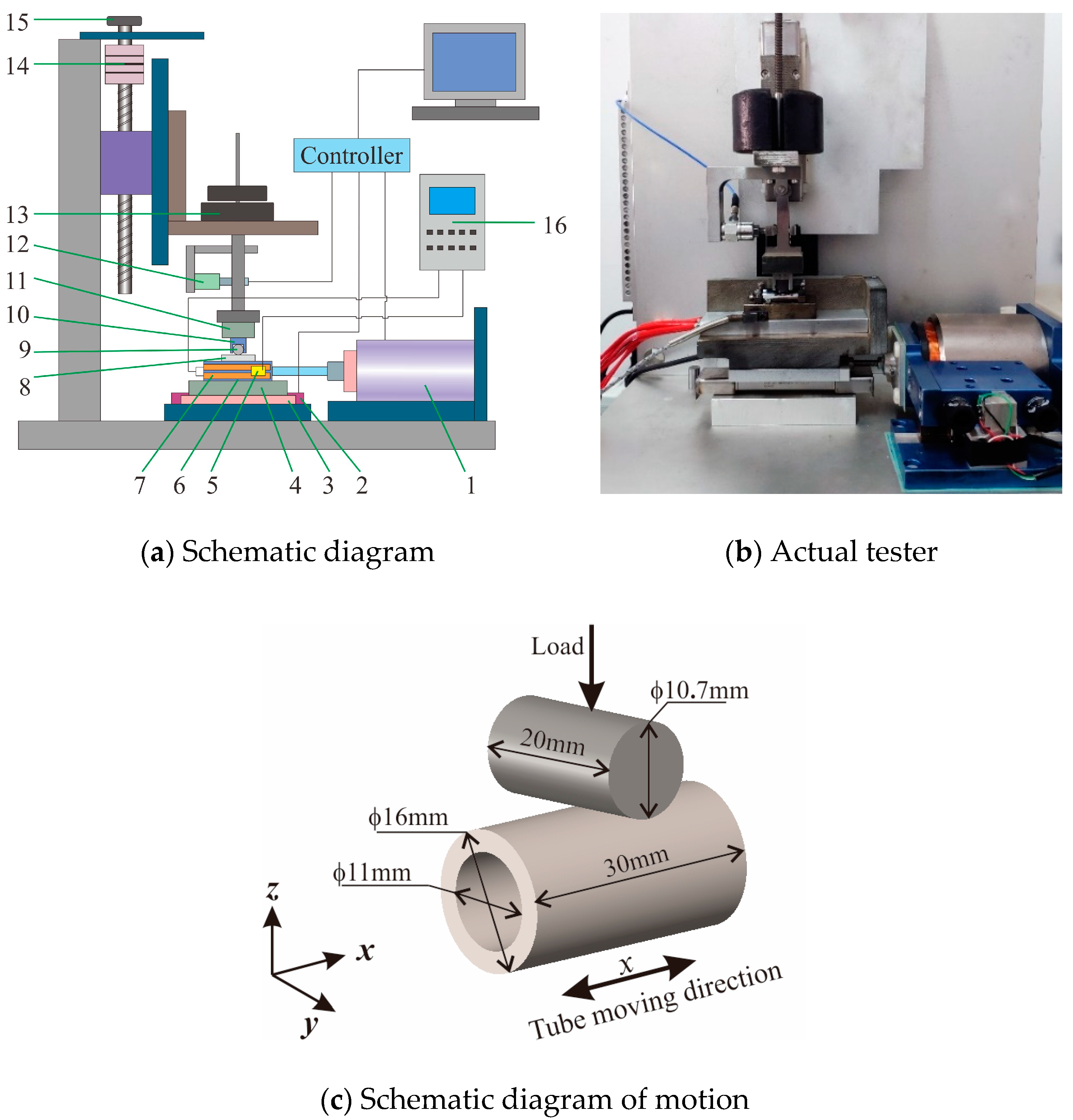
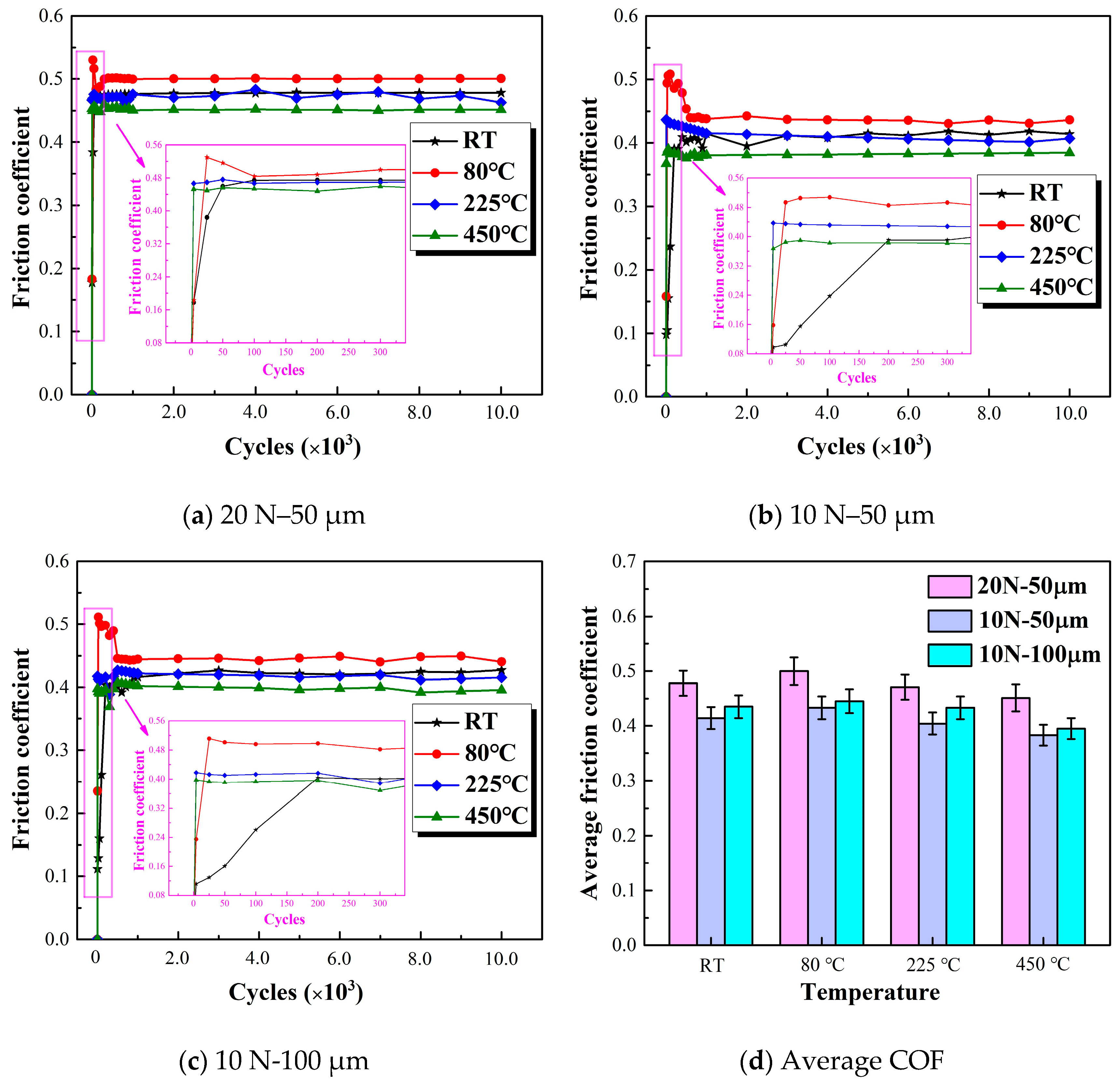


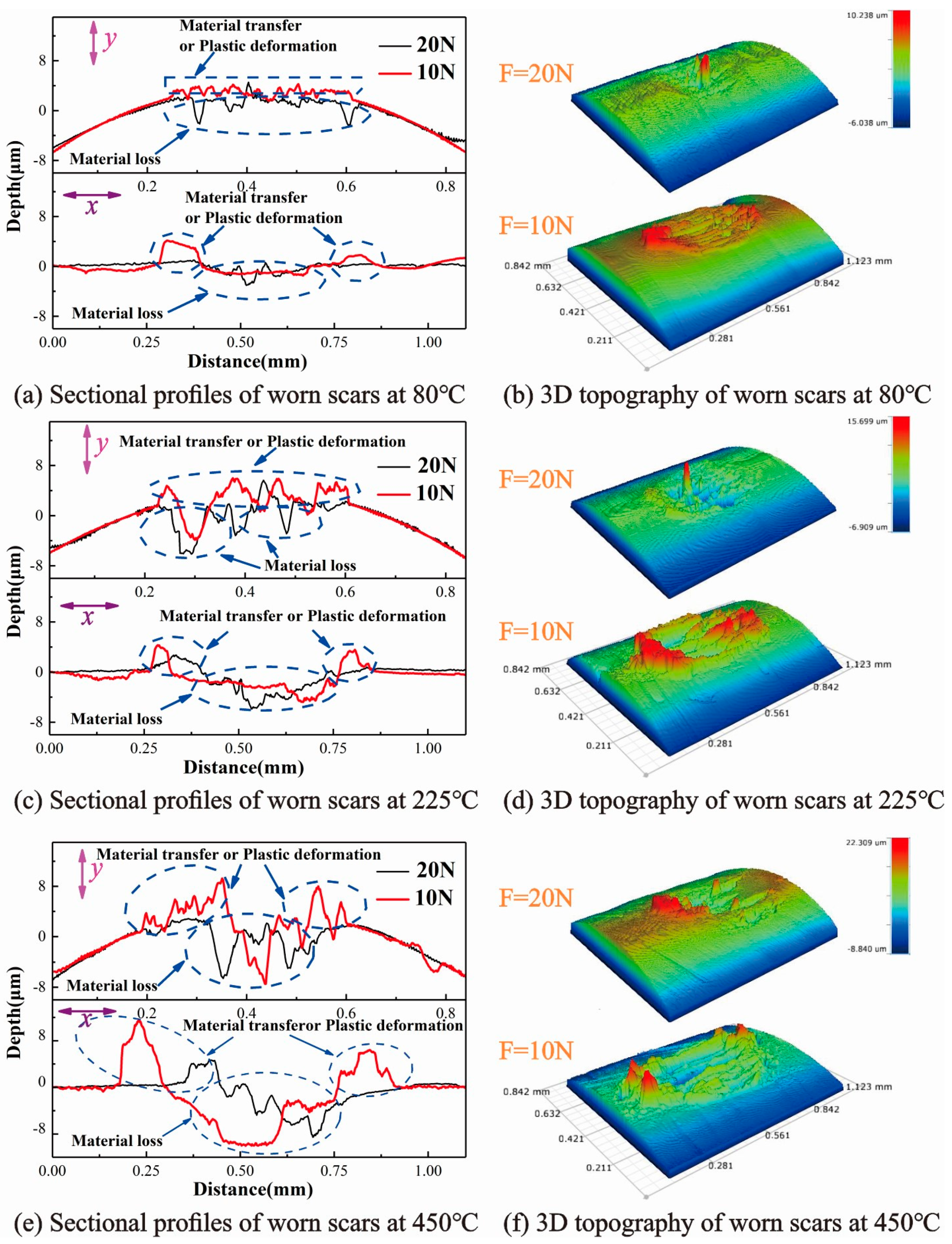
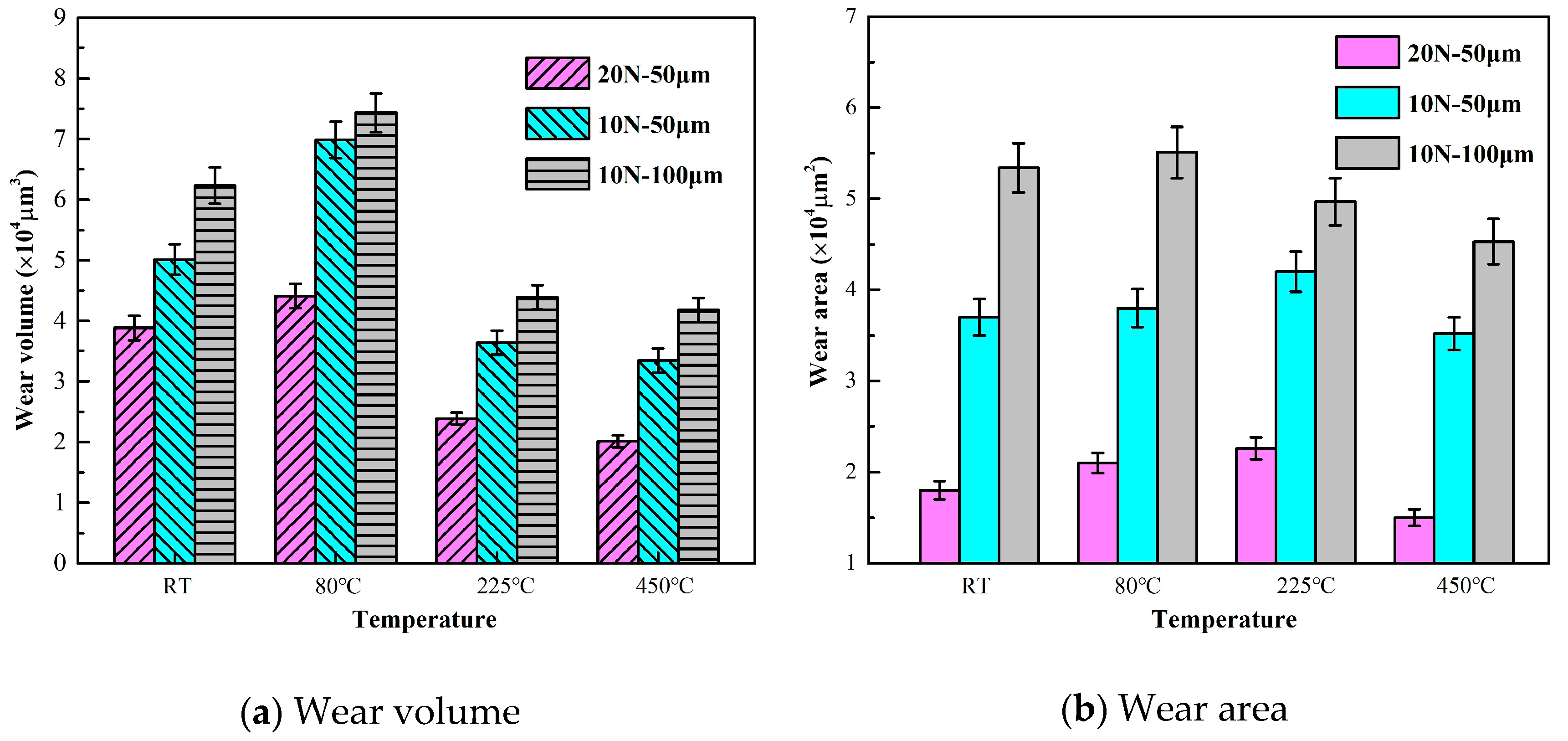
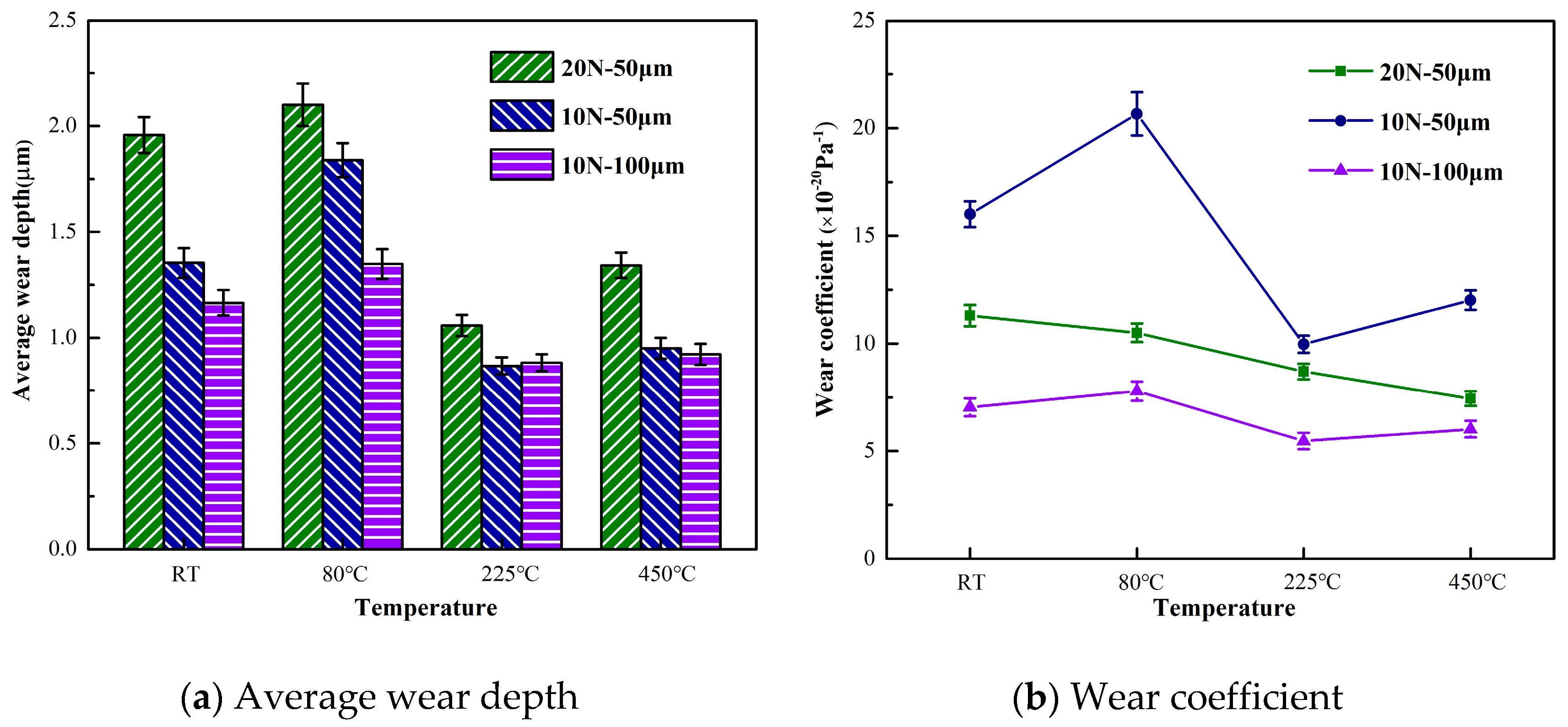

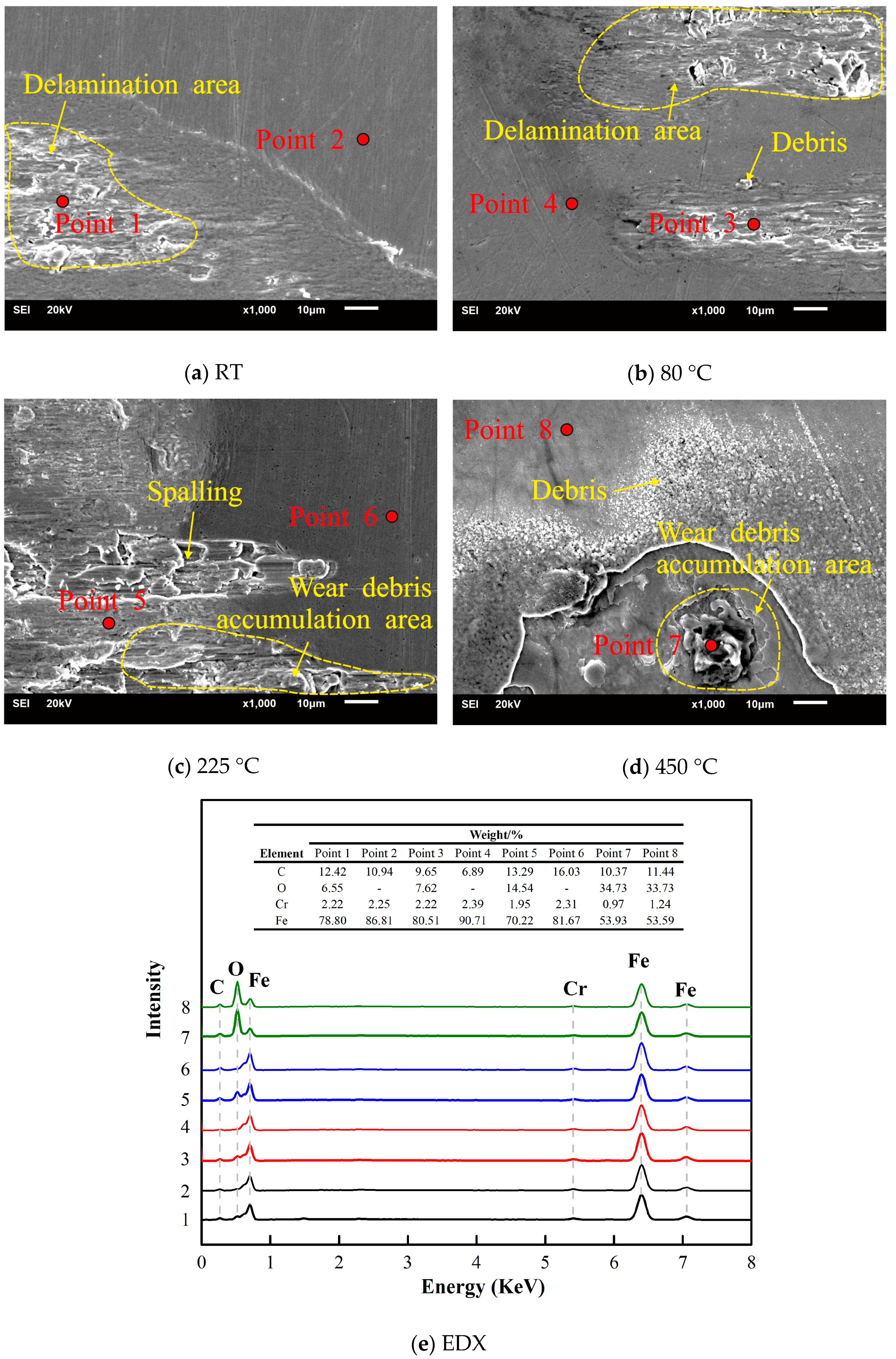
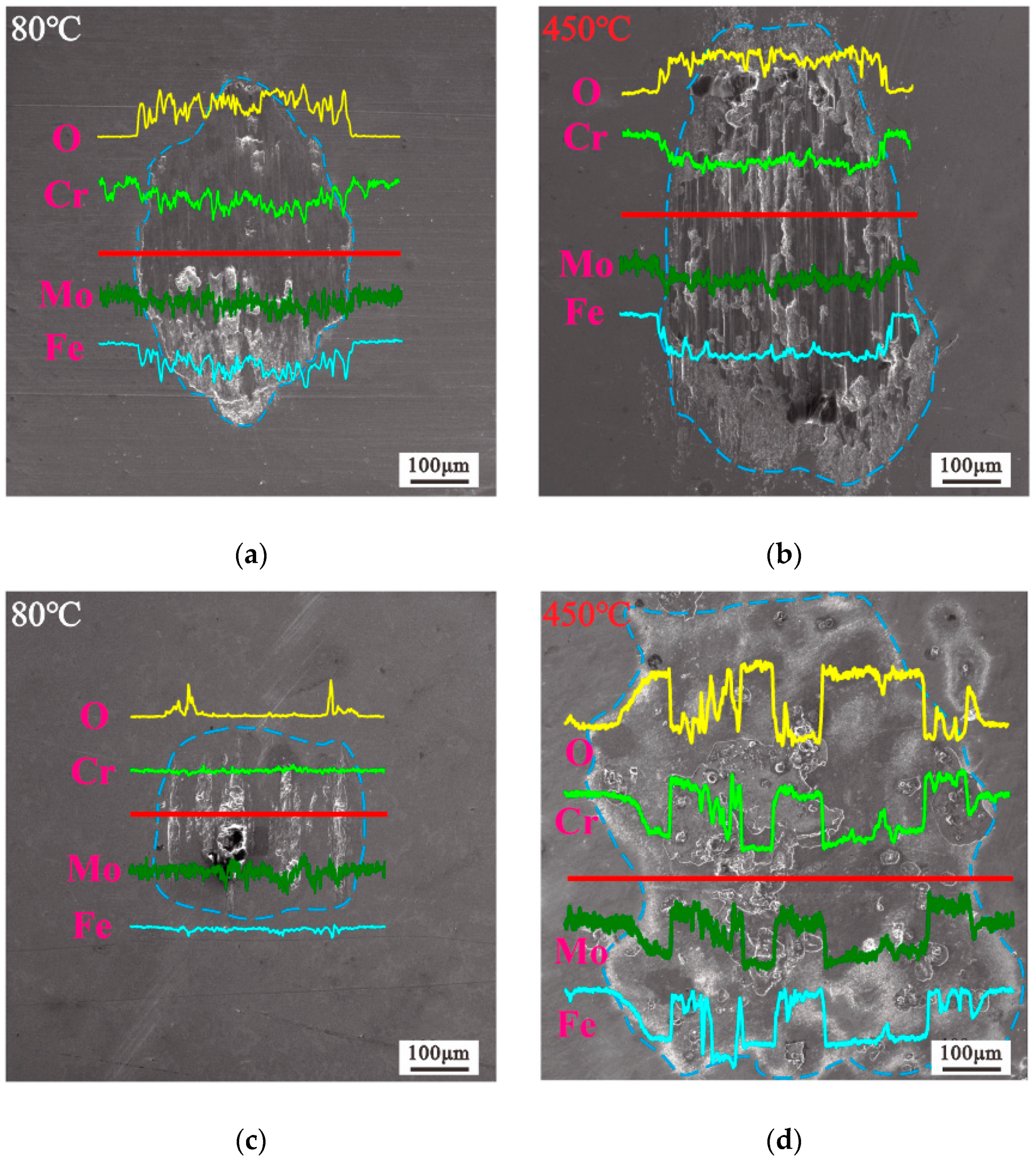
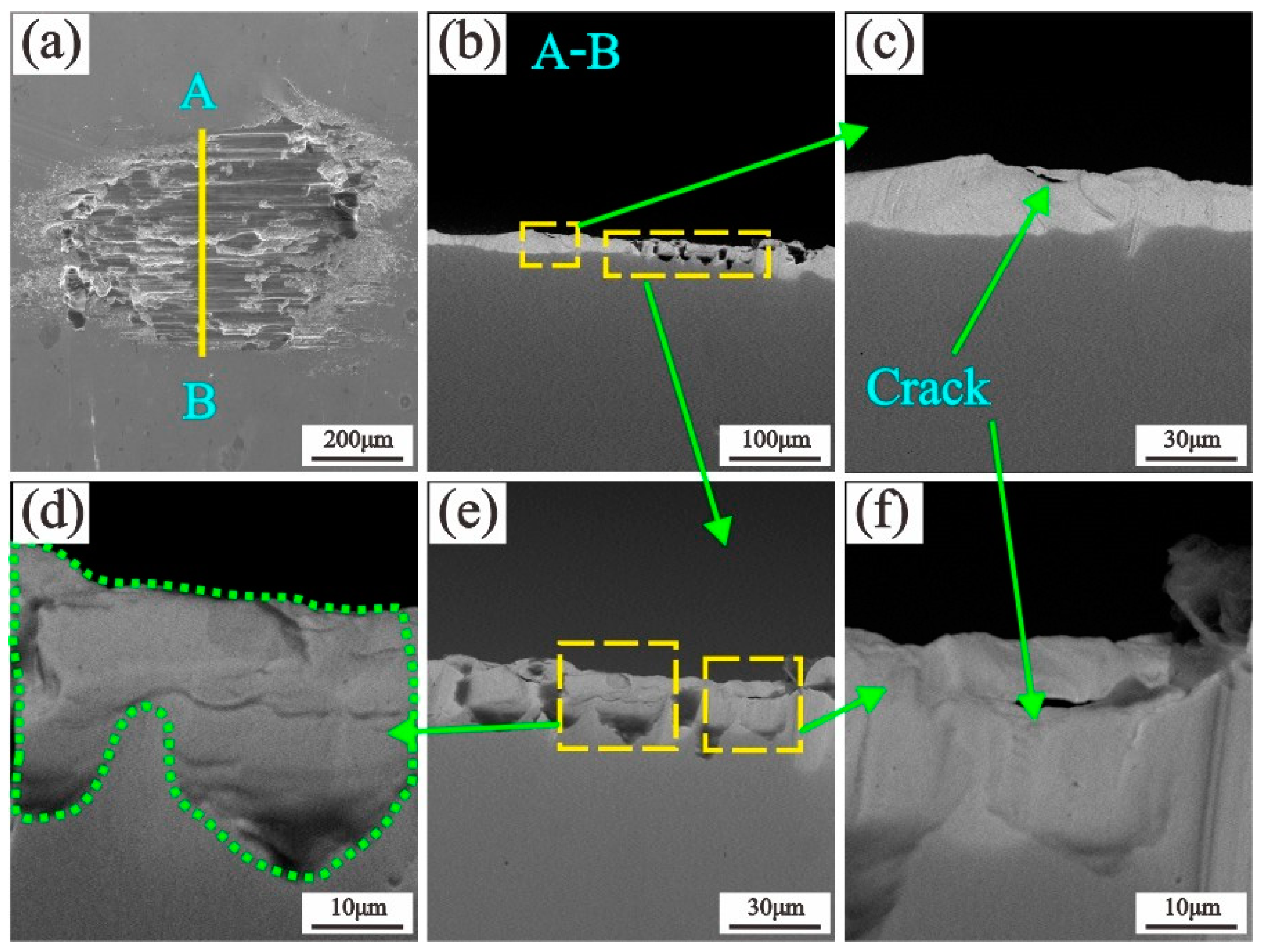

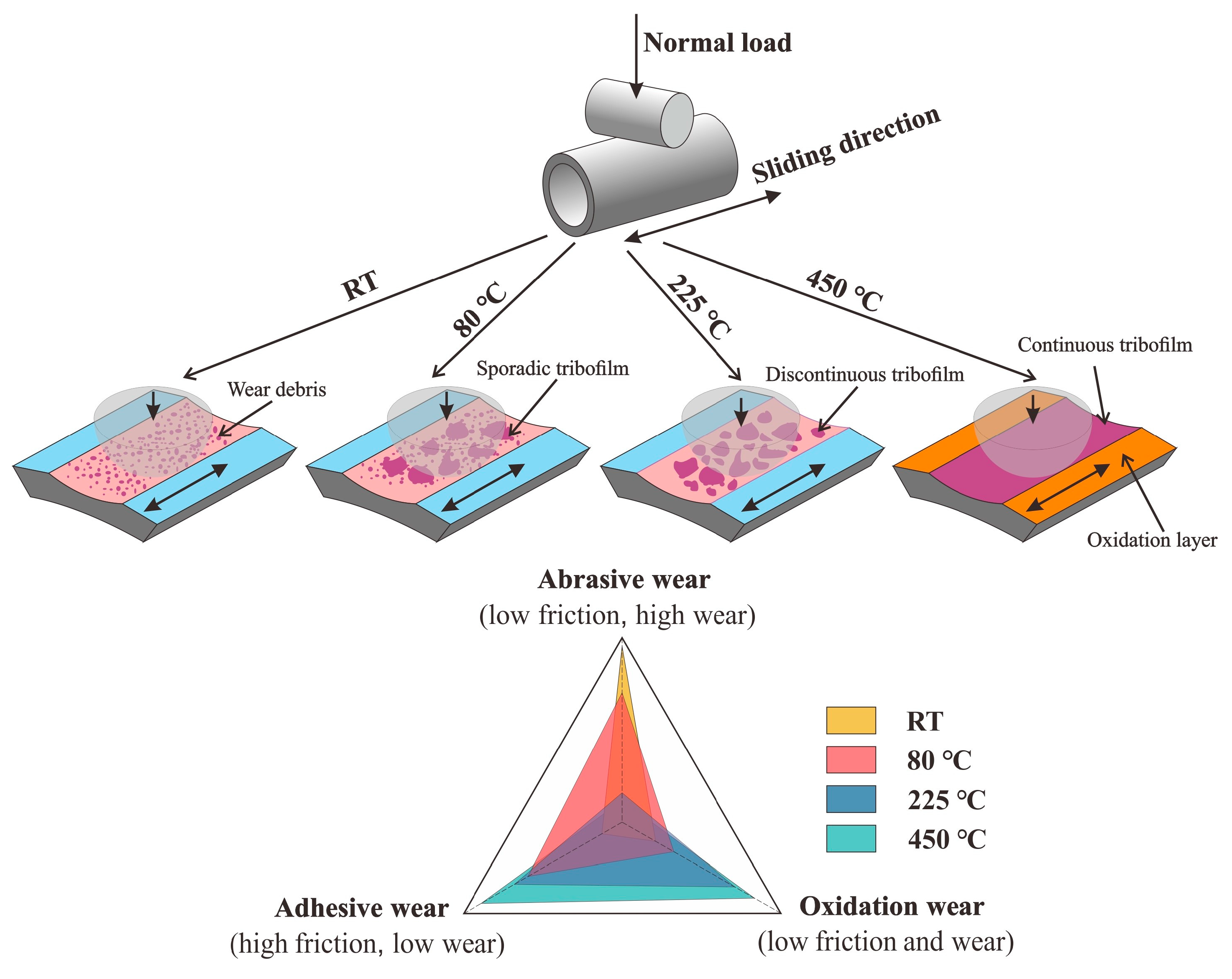
| Materials | Element | |||||||
|---|---|---|---|---|---|---|---|---|
| C | Mn | P | S | Si | Cr | Mo | Fe | |
| 2.25Cr-1Mo | 0.11 | 0.31 | 0.007 | 0.003 | 0.14 | 2.42 | 1.05 | bal |
| Gr5C12 | ≤0.15 | 0.30–0.60 | ≤0.035 | ≤0.035 | ≤0.50 | 4.00–6.00 | 0.45–0.65 | bal |
| Item | Value |
|---|---|
| Tube materials | 2.25Cr-1Mo |
| Tube hardness | 177.73 HV |
| Tube Young’s modulus | 194.73 Gpa |
| Rod materials | Gr5C12 |
| Rod hardness | 177.43 HV |
| Rod Young’s modulus | 179.32 Gpa |
| Temperature | RT, 80 °C, 225 °C, 450 °C |
| Load | 10 N, 20 N |
| Amplitude | 50 μm, 100 μm |
| Frequency | 5 Hz |
| Number of cycles | 104 cycles |
© 2020 by the authors. Licensee MDPI, Basel, Switzerland. This article is an open access article distributed under the terms and conditions of the Creative Commons Attribution (CC BY) license (http://creativecommons.org/licenses/by/4.0/).
Share and Cite
Chen, X.-D.; Wang, L.-W.; Yang, L.-Y.; Tang, R.; Cai, Z.-B. Effects of Temperature on the Fretting Wear Behavior of 2.25Cr-1Mo Tubes against Gr5C12 Rods. Materials 2020, 13, 3388. https://doi.org/10.3390/ma13153388
Chen X-D, Wang L-W, Yang L-Y, Tang R, Cai Z-B. Effects of Temperature on the Fretting Wear Behavior of 2.25Cr-1Mo Tubes against Gr5C12 Rods. Materials. 2020; 13(15):3388. https://doi.org/10.3390/ma13153388
Chicago/Turabian StyleChen, Xu-Dong, Li-Wen Wang, Ling-Yun Yang, Rui Tang, and Zhen-Bing Cai. 2020. "Effects of Temperature on the Fretting Wear Behavior of 2.25Cr-1Mo Tubes against Gr5C12 Rods" Materials 13, no. 15: 3388. https://doi.org/10.3390/ma13153388
APA StyleChen, X.-D., Wang, L.-W., Yang, L.-Y., Tang, R., & Cai, Z.-B. (2020). Effects of Temperature on the Fretting Wear Behavior of 2.25Cr-1Mo Tubes against Gr5C12 Rods. Materials, 13(15), 3388. https://doi.org/10.3390/ma13153388





